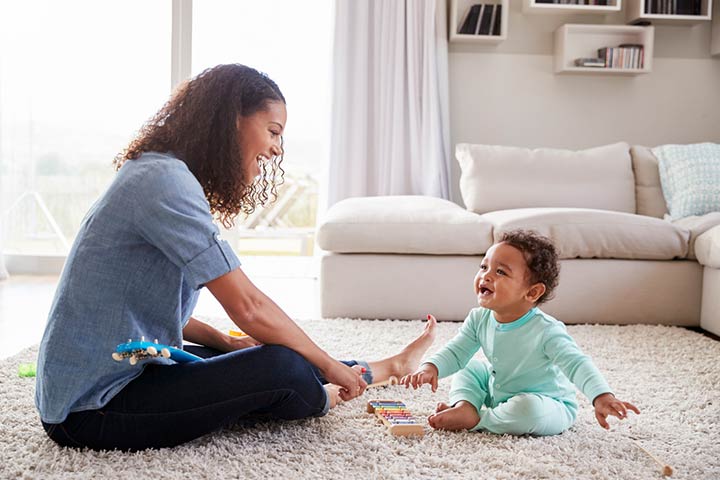
Image: iStock
While caring for your baby, you must have noticed how they try to signal you for their needs. Usually, it’s the basic needs like being hungry or needing a leak, and you have probably already grown accustomed to how they react in these situations. However, as a mother, you wish to talk with your baby and better understand their needs. So, you patiently wait for the time when your child is able to talk and communicate with you. But babies start muttering a few words after six months of age and it will probably take a couple more years before they can form proper sentences (1). No worries! This doesn’t mean you can’t already start communicating with them. Similar to how you can guess their food or pooping demands from their body language, you can also understand and communicate with them using sign languages.
Let’s look at what baby sign language is all about and how it can be really helpful to new parents!
1. What Exactly Is Baby Sign Language?
As the name suggests, baby sign language is essentially a form of communication between you and your baby, with the help of non-verbal cues. It is an attempt to express and understand their needs. Baby sign language is helpful for you to communicate with your little one before they begin to learn how to speak using words (2).
But trying to guess what your infant wants to convey is not always that easy. And when you don’t have a reliable way to convey, chances of miscommunications are high. This can be frustrating to both the mother and child. In this case, teaching your baby certain gestures to indicate their needs would go a long way in improving communication. Employing sign language communication from an early age is also a great way to improve the cognitive skills of children (2).
2. Will It Delay Or Affect Verbal Development?
Many mothers worry that if they use baby sign language, their little one will be slow to pick up verbal communication or have speech delays. This is however far from the truth. Researchers have found that, contrary to popular belief, baby sign language can positively affect language development. When babies learn to communicate via signs, it stimulates them to learn more ways of communicating with you. Also, if you couple baby sign language with verbal cues, your baby learns both (2).
With the help of baby sign language, it becomes easier for your baby to communicate with the rest of their family members, and this, in turn, can pave the way for a better social experience. You could get the people who interact with your child to use a few signs to communicate with your child. This way, your kid won’t get confused with new signs that probably mean the same thing.
3. Is Baby Sign Language And ASL The Same?
ASL, or American Sign Language, is a complex system of communication complete with grammatical rules and structure. In fact, it is a whole language system to help people who suffer from partial or complete hearing loss and people who are mute (3).
Baby sign language, on the other hand, is just a mechanism you use to enhance communication and understanding between you and your child. There is no complex system in place, and all you use here are hand motions, facial expressions, sounds, and verbal cues.
4. Tips For Baby Sign Language
Now that you understand what baby sign language is and why you should be using it, let’s get you started with a few tips:
- Get An Early Start:
It will help if you begin using sign languages as early as possible when your baby displays the need to communicate. You can start with hand gestures and facial expressions when it’s time to feed, or when you have to convey simple but essential words such as “hungry”, “mom”, “dad”, “food”, “toilet”, “pain”, to name a few.
- Look Out For The Signs They Create:
Sometimes, your little one will come up with signs of their own. Encourage this, and use these same signs to communicate with them. They can relate to this better. You could build on these signs with verbal cues.
- Utilize Only A Limited Number Of Signs:
There’s only so much a baby can learn. Be patient. Don’t try to overdo it with too many signs. Stick to the important ones that they will need on a daily basis. You can add a few more here and there slowly as they progress.
- Accompany Signs With Words And Sounds:
Remember that baby sign language is primarily used to enhance communication with words. So, when you are using sign language to communicate, accompany this with words and sounds too. For example, if you are trying to tell your child not to do something, use hand motions, but also say the word “no”.
- Consistency Is Key:
It’s only through the daily regular practice of using sign language that your baby will grow comfortable with using it. Parents have to make sure that they engage their children in this practice. Though the initial days could be a little hard for the habit to set in, soon you will start enjoying the great communication rapport between you and your child.
- Reward Them When You See Progress:
When you use positive reinforcement, your child understands that what they did was appreciated, due to which, they are facing positive consequences such as rewards. This motivates them to learn better. Show them that you’re happy with all the progress they’ve made! (4).
- Use Resources:
There are plenty of resources available that can help you with baby sign language. Look up sign language videos online, or buy baby sign language books. Some hospitals and community centers also have classes. Sign up for these so you can learn and make good use of them for your baby.
Be patient with your child through the whole process. Make sure you involve the rest of your family members too. Using sign language to communicate with your child can be so much fun! Try it! We hope you have a great time exploring the world of sign languages. Have you tried any of them? Let us know what worked for you in the comments below!
References
- How Young Children Learn Language And Speech: Implications Of Theory And Evidence For Clinical Pediatric Practice
https://www.ncbi.nlm.nih.gov/pmc/articles/PMC7236655/ - Enhancing Early Communication through Infant Sign Training
https://www.ncbi.nlm.nih.gov/pmc/articles/PMC1868823/ - Sign Language
https://www.ncbi.nlm.nih.gov/books/NBK11058/ - Behavior Modification
https://pubmed.ncbi.nlm.nih.gov/29083709/
















